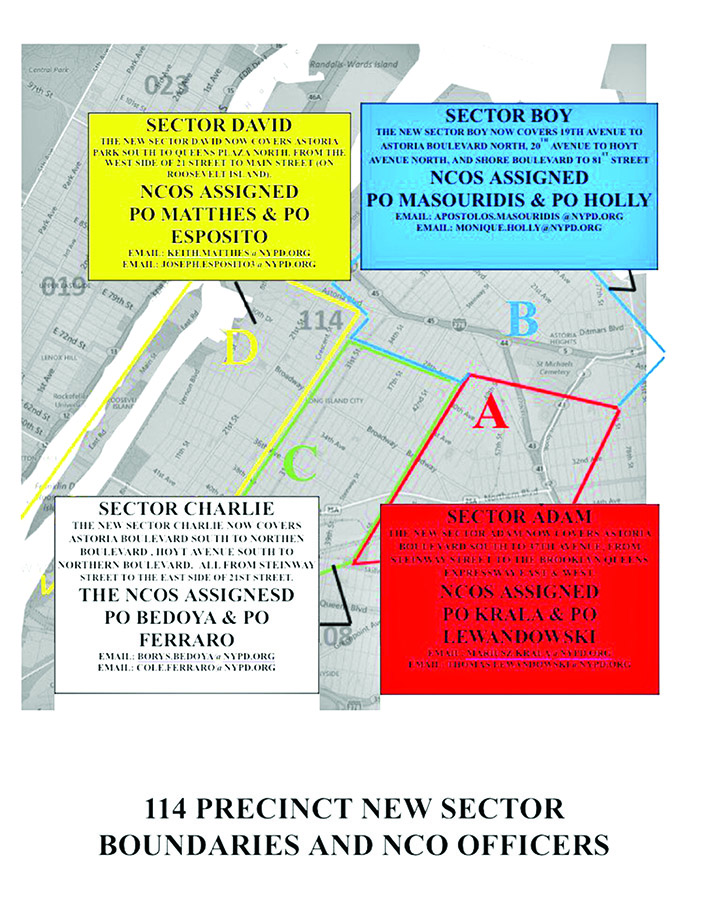Courtesy of NYPD
Astoria’s 114th Precinct is the latest command to implement the NYPD Neighborhood Policing Plan, which includes Neighborhood Coordination Officers and new sector boundaries.
By Michael V. Cusenza
The City Police Department has rolled out its Neighborhood Policing Plan to more than half of its 77 precincts and all nine Housing Police Service Areas, according to the NYPD.
The 114th Precinct in Astoria is the latest borough command to implement the strategy that is the brainchild of Police Commissioner Jim O’Neill and Chief of Department Carlos Gomez.
“[T]o close the gap in trust and approval of police, we have to do more than eliminate unnecessary enforcement activity. We have to fundamentally change the way we do our business,” O’Neill noted in recent remarks in front of the Association for a Better New York. “The NYPD’s Neighborhood Policing Program marks the first time any police department, anywhere, is totally reorganizing to deliver the same cops, in the same neighborhoods, every day. So, now we will know members of the community, know the problems, and work together to solve them.”
The newly minted top cop said the public that the Police Department protects and serves will soon have the names, email addresses, and cell phone numbers of the individual police officers who patrol their streets every single day.
“This is not a repackaged version of prior generations’ ‘community policing.’ This is very much a crime-fighting model – because fighting crime is what we get paid to do. It’s what you need us to do. At the same time, we are strengthening the relationships between cops and the people who live and work in every neighborhood,” O’Neill said. “As I tell all our officers, rookie and veteran alike: New Yorkers in every neighborhood want to see you. They want the police to help them. They’re glad we’re there on their streets.”
As O’Neill explained earlier this year, the Neighborhood Policing Plan divides precincts into four or five fully staffed sectors that correspond, as much as possible, to the boundaries of actual existing neighborhoods. Sector officers assigned to these sectors work the same neighborhoods on the same shifts, increasing their familiarity with the local residents and local problems. The radio dispatchers, supervisors, and sector officers work together to maintain “sector integrity”: the sector officers and sector cars do not leave the boundaries of their assigned sectors, except in genuine emergencies. The plan seeks to foster a sense of ownership among sector officers for the people, the problems, and even the perpetrators in a particular sector; a sense of geographic responsibility and accountability, O’Neill said.
Supporting the sector officers and filling out each sector team are two cops designated as the neighborhood coordination officers. The NCOs are conceived as liaisons between the police and the community, but also as key crime-fighters and problem solvers in the sector, according to O’Neill. While they answer some radio calls to keep them conversant with the daily workload, the NCOs spend more time actively familiarizing themselves with the community to better respond to neighborhood-specific crime and other conditions. The NCOs immerse themselves in the community by attending meetings with community leaders and clergy, visiting schools, following up on previous incidents, and using creative techniques and adaptive skills to fight crime unique to their particular sectors.
“We’ve now pivoted toward a model of policing that connects better with communities – a plan that not only lowers crime even more, but forges real, lasting relationships with those we serve,” O’Neill said.

